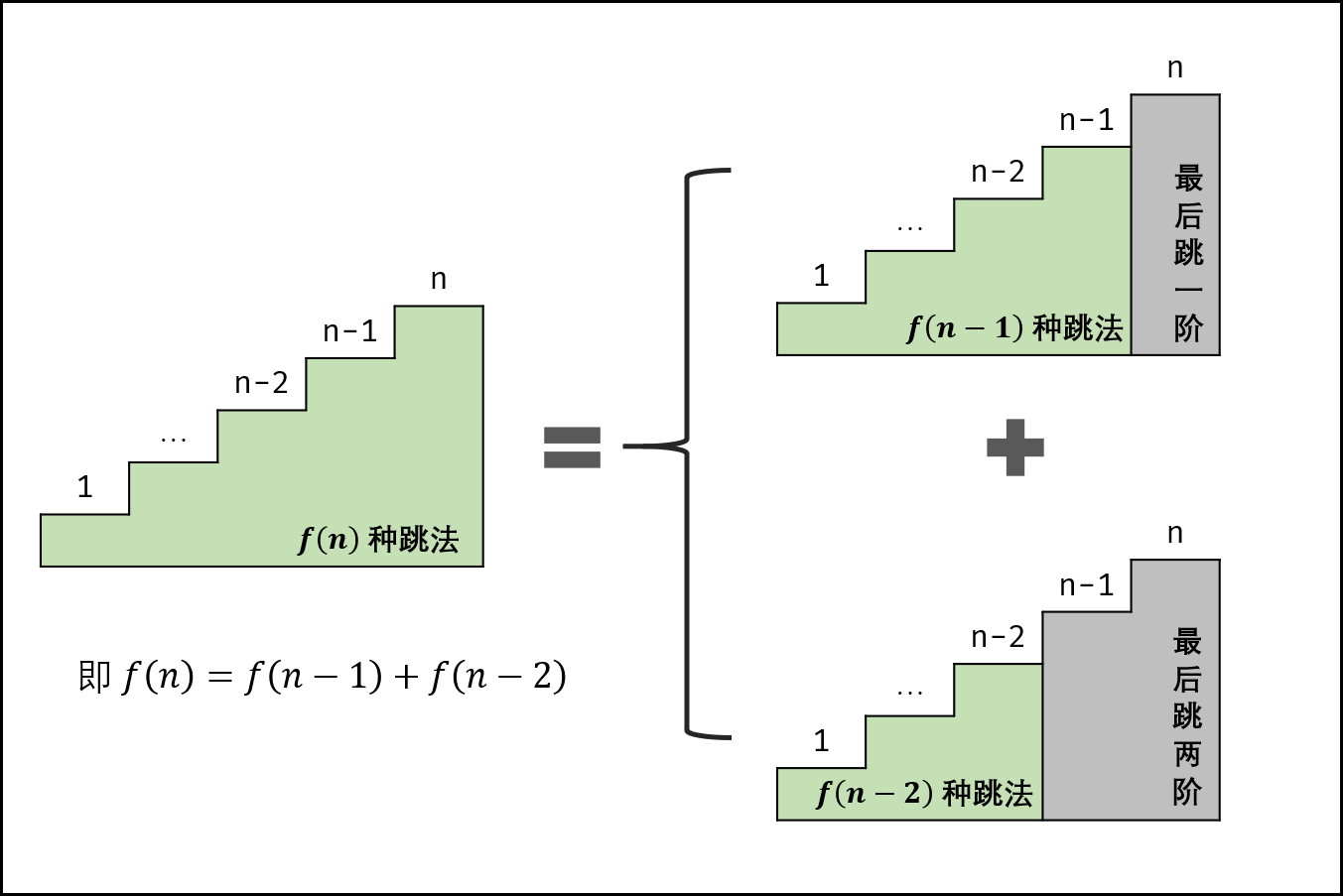友情支持
如果您觉得这个笔记对您有所帮助,看在D瓜哥码这么多字的辛苦上,请友情支持一下,D瓜哥感激不尽,😜
|
|
有些打赏的朋友希望可以加个好友,欢迎关注D 瓜哥的微信公众号,这样就可以通过公众号的回复直接给我发信息。

公众号的微信号是: jikerizhi。因为众所周知的原因,有时图片加载不出来。 如果图片加载不出来可以直接通过搜索微信号来查找我的公众号。 |
70. 爬楼梯
假设你正在爬楼梯。需要 n 阶你才能到达楼顶。
每次你可以爬 1 或 2 个台阶。你有多少种不同的方法可以爬到楼顶呢?
示例 1:
输入:n = 2 输出:2 解释:有两种方法可以爬到楼顶。 1. 1 阶 + 1 阶 2. 2 阶
示例 2:
输入:n = 3 输出:3 解释:有三种方法可以爬到楼顶。 1. 1 阶 + 1 阶 + 1 阶 2. 1 阶 + 2 阶 3. 2 阶 + 1 阶
提示:
-
1 <= n <= 45
思路分析
最简单只有一个台阶,只有 1 种方法;
当有两个台阶时,可以从地面跳起;也可以从第一个台阶跳起;
以此类推:当第 n 个台阶时,可以从第 n-2 个台阶跳起;也可以从第 n-1 个台阶跳起。

到这里就很明显了,这是一个斐波那契数列。
让 D瓜哥 使用 动态规划的模式 来重新解读一下:
-
刻画一个最优解的结构特征:跳到第 n 个台阶最多的跳法。
-
递归地定义最优解的值:
dp[n] = dp[n-2] + dp[n-1]。 -
计算最优解的值,通常采用自底向上的方法:D瓜哥也按照动态规划(注意表格)的方式来实现,采用自底向上+备忘录的方式来求解,创建一个长度为 n+1 的数组,第 i 个元素表示有相应的跳法,则第 1 个元素为 1,第 2 个元素为 2。然后以此类推……
-
利用计算出的信息构造一个最优解。这一步不需要,暂时忽略。
D瓜哥 再插播一句,知道是斐波那契数列,各种解法都好搞了,甚至可以使用斐波那契数列公式来解题了。😆
\$F_{n}=1 / \sqrt{5}\left[\left(\frac{1+\sqrt{5}}{2}\right)^{n}-\left(\frac{1-\sqrt{5}}{2}\right)^{n}\right]\$
-
一刷
-
二刷
-
三刷
1
2
3
4
5
6
7
8
9
10
11
12
13
14
15
16
17
18
19
/**
* Runtime: 0 ms, faster than 100.00% of Java online submissions for Climbing Stairs.
*
* Memory Usage: 40.8 MB, less than 5.26% of Java online submissions for Climbing Stairs.
*
* Copy from: https://leetcode.com/problems/climbing-stairs/solution/[Climbing Stairs solution - LeetCode]
*
* @author D瓜哥 · https://www.diguage.com
* @since 2020-01-23 21:29
*/
public int climbStairs(int n) {
int[] dp = new int[n + 1];
dp[0] = 1;
dp[1] = 1;
for (int i = 2; i <= n; i++) {
dp[i] = dp[i - 1] + dp[i - 2];
}
return dp[n];
}
1
2
3
4
5
6
7
8
9
10
11
12
13
14
15
16
17
/**
* @author D瓜哥 · https://www.diguage.com
* @since 2024-09-18 22:40:33
*/
public int climbStairs(int n) {
if (n < 3) {
return n;
}
int a = 1, b = 2;
for (int i = 3; i <= n; i++) {
int sum = a + b;
a = b;
b = sum;
}
return b;
}
1
2
3
4
5
6
7
8
9
10
11
12
13
14
15
16
17
18
19
/**
* @author D瓜哥 · https://www.diguage.com
* @since 2025-11-21 23:18:37
*/
public int climbStairs(int n) {
if (n == 1) {
return 1;
}
if (n == 2) {
return 2;
}
int a = 1, b = 2;
for (int i = 3; i <= n; i++) {
int sum = a + b;
a = b;
b = sum;
}
return b;
}

